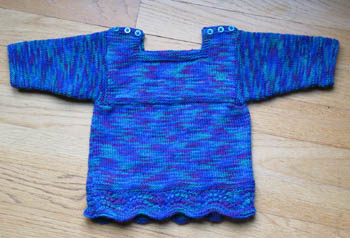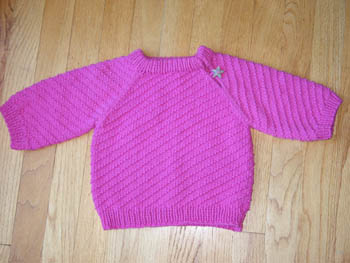Sizing
Babies grow very fast. In fact,
their mission in life for the first four to six
months is to double their weight. If you want
to make a sweater that will be worn for more than
a few weeks, knit the 6 to 12 month size. Babies
can wear the sweater when they are smaller with
the sleeves rolled up.

 In
determining what size sweater to make, take into
account when the baby will be born. Knitting a
sweater in a 6 to 12 month size for a baby born
in spring or summer works well. If the baby is
born in late fall or winter, consider making a
larger size (12 to 18 months) so that she/he has
something beautiful to wear the following year.
Usually parents get bombarded with newborn clothes
at baby showers and immediately after the birth.
It is nice to have something to look forward to
after those first garments are outgrown.
In
determining what size sweater to make, take into
account when the baby will be born. Knitting a
sweater in a 6 to 12 month size for a baby born
in spring or summer works well. If the baby is
born in late fall or winter, consider making a
larger size (12 to 18 months) so that she/he has
something beautiful to wear the following year.
Usually parents get bombarded with newborn clothes
at baby showers and immediately after the birth.
It is nice to have something to look forward to
after those first garments are outgrown.
A baby's proportions are very
different from that of an adult and an older child.
They have large heads. Also, they often do not
like being changed. So use a design that allows
for easy on and off. Cardigans are an obvious
choice. Or look for pullover designs that have
a button closure along one or both of the shoulder
seams. An example of this type of sweater can
be seen above.

 Another
option is to create a button closure along a raglan
seam so that there's large opening for baby's
head. On the right, see an example of this style.
Another
option is to create a button closure along a raglan
seam so that there's large opening for baby's
head. On the right, see an example of this style.
Color of yarn
Many parents/parents-to-be know
the sex of their baby before the birth. This makes
color selection easier. But it doesn't mean that
your colors should be limited to pastel blue or
pink. There are many wonderful colors available.
Babies look especially beautiful in deep jewel
tones. If the parents don't know the sex of their
baby, consider using a deep red or teal green
colored yarn. There are shades of blue that work
just as well for both sexes.
Alternatives to sweaters
There are many items other than
sweaters to knit for babies. If you want a larger
scale project, consider making a blanket. It is
helpful to have multiple blankets: one for the
car, another for a stroller, or a back-up when
one is in the wash.
Another item I enjoy making
is booties. It's a great way to use up leftover
sock yarn. Babies can have very wiggly feet, so
look for designs with a ribbed cuff or an i-cord
(or similar) closure so they stay put. Keep in
mind that booties and socks for babies are best
made for pre-walkers. An infant in booties who
is pulling up to a stand, cruising (moving while
holding on to hands or furniture) and walking
could slip.
Hats are another fun item to
make. Many knitters have made the fruit caps but
there are many others to try. Make sure the yarn
is soft. Baby foreheads can be especially sensitive
to wool. Newborns tend not to have much in the
way of necks, so I usually avoid designs with
a below-the-chin closure. On the other hand, with
older infants (9-12 months), having a below-the-chin
strap will ensure that the hat stays on.
Knitting for a baby who has a
parent who knits
Some knitters, especially new
ones, fret about knitting for a baby of a parent
who knits. Don't let this hold you back. A parent
who knits will understand and appreciate the work
that you put into making a gift. Don't worry about
making something to wow the parents. There are
many beautiful, simple, and practical designs
available today. You will be giving a gift that
will be used again and again and treasured.

